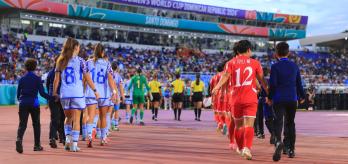Key Observations
-
76.7% of the 159 players at the World Cup born between 1997 and 2002 had youth international appearance up to U-21 level. This high percentage indicates the importance of providing competitive playing opportunities and international experience to a wide group of promising young players.
-
Remarkably, 8 young players within the squad of World Cup winners Argentina, and 14 players for finalists France, participated in recent youth World Cups and/or had playing opportunities in youth international matches. International youth football can be seen as a significant development pathway to the senior World Cup for these teams, which focus on participation and performance at youth national team level.
-
The number of players from CAF associations who made the transition from youth World Cups to FIFA World Cup squads is strikingly low. A more effective talent identification system, a better selection process, and organising more international youth games and tournaments for young players could help raise this number and accelerate the development of top talents for senior national teams.
Scope of study
This article analyses a sample of 159 players born between 1997 and 2002 who went on to play in FIFA World Cup Qatar 2022™. The aim of this study is to examine how national associations use their national youth teams as a development pathway for their senior sides. With this in mind, the 159 players in our sample are drawn from 24 national associations, all of which qualified for at least one of four junior tournaments: the U-17 World Cups of 2017 and 2019, and the U-20 World Cups of 2017 and 2019.
Involvement in youth World Cups
Of the 32 nations represented at the finals of the senior men’s World Cup in 2022, 24 were involved in at least one of the four junior tournaments. Of these, four countries qualified for all four (France, Japan, Mexico and USA), and four qualified for three of the four competitions (Argentina, Ecuador, South Korea and Senegal). Of the others, nine nations made it to two of the tournaments, with the remaining seven qualifying for just one. Among the countries playing in Qatar, Morocco and Tunisia are the only non-European representatives not to have qualified for any of the last four U-17 or U-20 World Cups.
Bringing youth World Cup experience to Qatar
This study covers 159 players who were eligible to represent their country at a U-17 or U-20 FIFA World Cup. For a player to be considered eligible, their country had to have qualified for the tournament, and the player concerned had to have been eligible to be called into the squad for that tournament.The first interesting figure to note is that, of the 159 players at FIFA World Cup Qatar 2022™ who would have been eligible to play in at least one of the last four U-17 or U-20 World Cups, 74 actually got game time in these competitions, or 46.5% of those eligible. This percentage varies greatly between national teams; 100% of eligible Qatari players (two of two) played in at least one junior tournament, while the percentage was 0% for six associations, including one European nation (the six are Australia, Brazil, Cameroon, Canada, Germany and Iran).
If we ignore the percentage of players who actually played in these tournaments and instead look at the percentage of our 159 players who would have been eligible to play in them if selected, the numbers show that national associations are giving young players more opportunities. The United States stands out; 15 players in its squad in Qatar would have been eligible to play in one of the four junior tournaments, and eight of them actually did so, a percentage of 53.3%. They are followed in the rankings by Ecuador (14 eligible players, with nine of them having played at the U-17 or U-20 World Cup) and France (14 eligible players, three of whom actually played in a youth World Cup).
If we analyse the same figures by confederation, we see that the CONMEBOL associations have a total of 37 players in their squads for the 2022 World Cup who were previously eligible to play in our four junior tournaments. Of these, 23 actually played in an U-17 or U-20 World Cup (62.2%). The equivalent percentage for the AFC is also above 50%, at 58.6%, but the figure falls below the 50% mark for the remaining confederations, and as low as 29.4% for CAF – although it should be emphasised that this still represents more than a quarter of eligible players.
Players who represented their country at junior level
As well as calculating how many players at the World Cup in Qatar played in one of the last four youth FIFA U-17 or U-20 World Cups, we also analysed whether the 159 players who were potentially eligible for these competitions had played any youth international matches up to U-21 level for the country they are representing at the 2022 World Cup. The overall percentage of our 159 players at the World Cup who previously represented their country at youth level is 76.7% (as opposed to 46.5% who played at youth World Cups). Hence, we can say that over three quarters of the players our sample had previously played in their national youth sides.
When we look at the same statistic broken down by confederation, the sides representing UEFA associations have the highest percentage of former youth internationals in their 2022 World Cup squads (fully 95.6%, or 43 out of 45 players). At the opposite end of the spectrum is CAF, at 29.4% (5 players out of 17). This reflects different approaches to using national youth teams as a pathway to senior international football.
Conclusion
Almost half of the 159 players at FIFA World Cup Qatar 2022 who would have been eligible to play in the last four FIFA U-17 or U-20 World Cups actually played in those junior competitions (46.5%). Moreover, 76.7% of those players (122 of 159) represented their countries at youth level up to and including the U-21s. This percentage is above 66% for all the confederations except CAF, which indicates the need to improve and develop talent identification systems in Africa and make the pathway from youth to senior international football more effective.



























